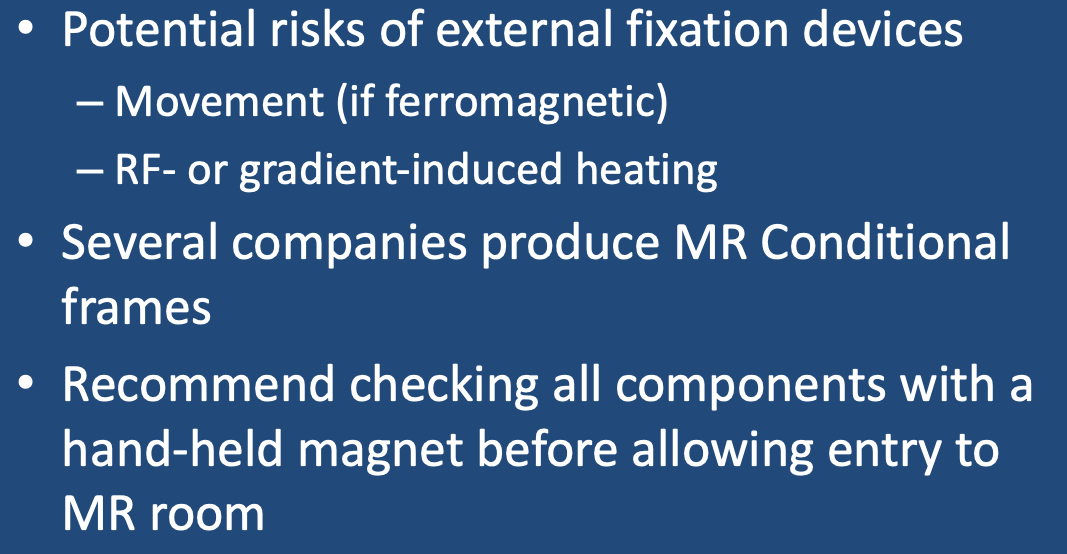 Pelvic external fixation device
Pelvic external fixation device
External fixation is a surgical technique in which the proximal end of a pin or bolt is screwed into bone while the other end is connected to a stabilizing structure outside the body. The usual clinical indication for external fixation devices is to stabilize complex, open, or infected fractures, especially those of the pelvis or long bones. The distal ends of each pin are attached by clamp connectors to a framework of rods that can be adjusted as needed to improve alignment.
Several potential risks are associated with external fixation devices in the MR environment:
- Magnetic displacement or rotation of the frame if certain components are ferromagnetic.
- RF- or gradient-induced heating of the device with resulting thermal burns along pin tracts or where the frame is in contact with the skin. Because the device is predominantly outside the body where the E-field is strongest, conductive currents may be induced in the rods.
Nearly two dozen companies worldwide manufacture external fixation hardware, the largest being DePuy Synthes, Zimmer Biomet, Stryker, Smith & Nephew, and Orthofix, Most offer systems that are MR Conditional up to 3.0T. The screws and connectors MR-compatible devices are typically composed of titanium- or cobalt-based alloys (Elgiloy, MP35N), while the rods must be made of a non-conducting material (fiberglass, carbon fiber reinforced epoxy). The conditions vary widely among the manufacturers, including limitations on specific device configurations and distance of the frame from magnet isocenter, in addition to the usual field strength and SAR considerations.
Care must be taken in evaluating external fixation devices, as occasionally ferromagnetic parts from one system can be mixed with non-ferromagnetic parts from another. For example, the MRI- and non-MRI-compatible components of the Stryker's Hoffman II fixation system are structurally interchangeable and can be distinguished only by color and labeling. It is always a good idea to test the frame with a hand-held magnet prior to entry into the MR suite. While it is OK for the pins to be ferromagnetic (since they are firmly affixed to bone) the remainder of the external structure should not be.
Even with fully MR-compatible external fixation arrays, an occasional patient may experience tingling or tugging during scanning, necessitating early termination of the scan. In some instances this may be due to vibrations in the frame due to gradient-switching-induced eddy currents. While harmless, these vibrations may be misinterpreted by the patient as heating. The phenomenon is more likely to occur when the fixation device is located far from magnet isocenter.
Advanced Discussion (show/hide)»
No supplementary material yet. Check back soon!
References
Gillig JD, Goode RD, Campfield B, et al. Safety and complications associated with MRI-conditional external fixators in patients with tibial plateau fractures: a case series. J Orthop Trauma 2018; 32:521-525. [DOI LINK]
Graf H, Lauer UA, Schick F. Eddy-current induction in extended metallic parts as a source of considerable torsional moment. J Magn Reson Imaging 2006; 23:585-590. [DOI LINK]
Liu Y, Shen J, Kainz W, et al. Numerical investigations of MRI RF field induced heating for external fixation devices. BioMedical Engineering OnLine 2013; 12:12. [DIRECT LINK]
Luechinger R, Boesiger P, Disegi JA. Safety evaluation of large external fixation clamps and frames in a magnetic resonance environment. J Biomed Mater Res Part B: Appl Biomater 2007; 82B:17–22. [DOI LINK]
Milby JN, Bible JE, Mosher TJ, Garner MR. External orthopedic implants in the magnetic resonance environment: current concepts and controversies. J Am Acad Orthopedic Surg 2020; 28:e139-e144. [DOI LINK]
Perry KJ, Massey PA, Simoncini A, Barton RS. MRI Safety of external fixation devices: a review of the literature. Curr Orthop Pract 2018; 29:302-307.
Gillig JD, Goode RD, Campfield B, et al. Safety and complications associated with MRI-conditional external fixators in patients with tibial plateau fractures: a case series. J Orthop Trauma 2018; 32:521-525. [DOI LINK]
Graf H, Lauer UA, Schick F. Eddy-current induction in extended metallic parts as a source of considerable torsional moment. J Magn Reson Imaging 2006; 23:585-590. [DOI LINK]
Liu Y, Shen J, Kainz W, et al. Numerical investigations of MRI RF field induced heating for external fixation devices. BioMedical Engineering OnLine 2013; 12:12. [DIRECT LINK]
Luechinger R, Boesiger P, Disegi JA. Safety evaluation of large external fixation clamps and frames in a magnetic resonance environment. J Biomed Mater Res Part B: Appl Biomater 2007; 82B:17–22. [DOI LINK]
Milby JN, Bible JE, Mosher TJ, Garner MR. External orthopedic implants in the magnetic resonance environment: current concepts and controversies. J Am Acad Orthopedic Surg 2020; 28:e139-e144. [DOI LINK]
Perry KJ, Massey PA, Simoncini A, Barton RS. MRI Safety of external fixation devices: a review of the literature. Curr Orthop Pract 2018; 29:302-307.
Related Questions
What causes implants to heat up during MR imaging?
What causes implants to heat up during MR imaging?
